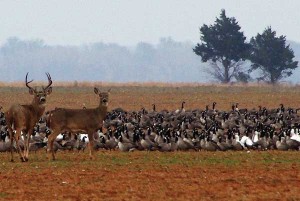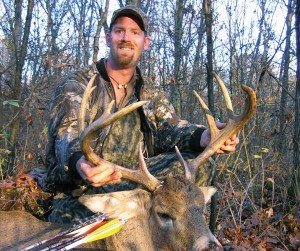September 18, 2013
By Tracy Breen
 Whitetails are, without a doubt, the most sought after big-game animal in America. As a result, finding a good place to hunt them can be difficult. Finding a decent buck on public land can be difficult, because there is so much hunting pressure.
Whitetails are, without a doubt, the most sought after big-game animal in America. As a result, finding a good place to hunt them can be difficult. Finding a decent buck on public land can be difficult, because there is so much hunting pressure.
Getting permission to hunt on private land can be difficult because farmers and large land owners lease their land or hunt it themselves.
Many bowhunters get discouraged and wind up hunting very little or giving up altogether. If you find yourself in this boat, realize you have another option. That option is to hunt a Wildlife Refuge.
It's Not What You Think
Advertisement
When bowhunters hear the name National Wildlife Refuge System, the first thought that may come to mind is that the name "refuge" must imply no hunting. It's true that many refuges around the country do not allow hunting. But there are some 545 refuges around the country and many of them do. Some only allow turkey hunting, waterfowl hunting or bowhunting for deer.
The fact that some leg work must be done to find out which refuges allow bowhunting and which ones don't weeds out the lazy hunters. Also, many refuges require hunters to put in for a draw or buy a permit — that will weed out even more. And some refuges require bowhunters to have taken a bowhunter education course and pass a proficiency test at the refuge.
If you are willing to jump through a few hoops, do a little homework and work hard, there's no reason you can't kill a good buck on a National Wildlife Refuge. Tom Reed from Montana knows a lot about hunting the Refuge System. Reed manages the Lee Metcalf Wildlife Refuge in Montana and is the former Hunting and Fishing Coordinator for the entire Refuge System.
Advertisement
"One thing that separates the Refuge System from other properties is that refuges are managed with wildlife in mind. Refuge managers, biologists and staff work together for the betterment of wildlife, which includes game species on the refuge. Hunters willing to put their time in can have good hunting opportunities on a refuge," Reed explained.
Habitat management is done on refuges and is beneficial to wildlife and hunters unlike it is elsewhere. Many refuges plant food sources for wildlife, provide water and make other habitat improvements.
Not all refuges are home to whitetails, and not all refuges offer hunting. If hunters are after whitetails, Reed recommends hunters do a little homework.
"There is plenty of information online about the Refuge System. Hunters need to locate a refuge near them and find out if it allows whitetail hunting and how the hunt is managed, if it is offered. One nice thing about many of the refuges that offer hunting is there is a lot of land to hunt on. Most refuges are made up of thousands of acres, so there is plenty of room for hunters to roam," Reed added.
The Wild, Wild West
Those who are willing to go on a road trip should consider hunting whitetails in the West on refuges such as Lee Metcalf where there are a few big bucks around.
"I think one of the reasons there are big whitetails in portions of the western United States is because most Western hunters seek out mule deer more than they do whitetails," Reed noted. "As a result, some whitetail bucks reach a ripe old age.
"The key to success on many refuges is figuring out the travel patterns of the deer. There are plenty of hunters that hunt here that wander around or pick a spot and hunt for a day. The bowhunters who consistently kill bucks here read the deer sign and figure out where the deer move on and off the refuge and get them coming and going between point A and B. Sometimes that is deep in the woods; other times it is right by the parking lot."
Many refuges are surrounded by private land or large parcels of public land where the deer often come and go. Hunters who figure out the patterns can take advantage of the refuge system whether they hunt within or outside the borders. Tom Johnson from Muskegon, Mich., has hunted public land near a refuge in Iowa and killed a 135-inch buck that spent time between a refuge and other public land.
"There have been plenty of times over the years when I traveled to hunt that I keyed in on refuges when choosing a place to hunt. Anytime I can be near a piece of large ground that has some tight regulations or limits hunting, I will be there because the deer that come and go from those areas often get old," Johnson said. "If you can hunt on a refuge, great. If you don't feel like jumping through hoops, hunting nearby can be the ticket also."
Brian Bonesteel from California is another bowhunter who takes advantage of the Refuge System. Bonesteel is a professional trapper who makes his living by getting rid of predators out West. In the fall, he heads to the Midwest and has had a lot of success hunting on Waterfowl Production Areas there. Although a Waterfowl Production Area (WPA) doesn't have the word refuge in its name, they are managed by the Refuge System and whitetail hunting is allowed on many of them.
"When most people think of a WPA, they think of a waterfowl hunting area, which it is, but it can provide great whitetail hunting," said Bonesteel.
 Waterfowl production areas are often marshland and prairie grass — something most bowhunters don't think of as whitetail ground. But Bonesteel says that's not the case.
Waterfowl production areas are often marshland and prairie grass — something most bowhunters don't think of as whitetail ground. But Bonesteel says that's not the case.
"Over the years, I have killed a few big bucks in the WPAs. There often isn't much food in the WPAs, so the big bucks will bed in the grass or the cattails and leave to feed. I often hunt near the bedding area," he explained.
In some areas of the country, refuges get hunted pretty hard for whitetails because many are extremely close to major cities and towns. WPAs, on the other hand, often don't receive the same amount of pressure.
"Many of the WPAs are much smaller than the refuges. So, I think they get overlooked by bowhunters," Bonesteel added. "The fact that duck hunting is taking place, in some cases in extreme close proximity to where the deer are bedding, also deters some hunters who think deer wouldn't be bedding in an area with lots of shotgun noise."
Ready To Go?
If hunting a refuge is starting to sound like a good idea to you, start planning your hunt months in advance by studying aerial photographs, topographic maps and calling ahead to get an idea of what you will need to do before the hunt. Some refuges allow scouting before the season; others don't allow you to scout at all. How you hunt is also tightly regulated.
"Some refuges allow treestands and blinds to be in place for a day or two; others make you take them down at the end of every hunt," Reed said.
And just like on other public property, branches cannot be removed to hang a treestand.
As taxpayers, we each pay our fair share so the Refuge System can flourish. Take advantage of the blue goose and all the wildlife the refuges have to offer by planning a hunt on a refuge near you.
For more information, and to locate a refuge in your neck of the woods, visit refuges.fws.gov.
